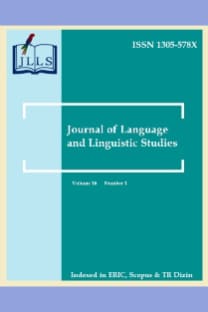Similar and unique in the family: How to raise children (Using examples of Turkish and Georgian proverbs relating to children)
Ailede benzer ve tek: Çocuk eğitimi (Türk ve Gürcü çocuklar hakkındaki
___
- Gormus, A., S & Aydın, S. (2008). Individualism as An Ascending Value in Turkey and A Research Conducted Among University Students, First International Conference On Management And Economics, Epoka University, Tiran.
- Gözpınar, H. (2011). Proverb- Its Semantic and Didactic Parametres. MA. Thesis. Tbilisi: Tbilisi State University
- Gvardjaladze, I. (1976).Georgian proverbs with their English equivalents.Tbilisi: Izd-voMetsniereva
- Levi-Strauss, C. (1968). Mythologiques III: L'Origine des manières de table.Paris: Plon
- Rusieshvili, M. (2005). The proverb (in Georgian). Tbilisi: Lomisi.
- Rusieshvili,M., &Lortkipanidze, K. (2010). Cultural similarities in proverbs (using Examples from Kartvelian and Azerbaijanian),International Conference "Current Advances in Caucasian Studies", Macerata.
- Taylor, A. (1962). The proverb.Pensylvania: Hatboro.
- Tsuladze, L. (2006).IndividualistTrends in CollectivistSocieties.International Conference Women of theMountains, UtahValleyStateCollege (UVSC) , USA Retrievedon December 16 from: http://womenofthemountains.org/files/Microsoft%20Word%20-%2007-03-03-From-Tsuladze-Conference_paper.pdf
- Yurtbasi, M.(1993). A dictionary of Turkish proverbs. Ankara: Turkish Daily News.
- ISSN: 1305-578X
- Yayın Aralığı: 4
- Başlangıç: 2005
- Yayıncı: http://www.jlls.org
Foreign language learners' views on the importance of learning the target language pronunciation
A cross-sectional study of Iranian EFL learners' polite and impolite apologies
Seyyed Hatam TAMİMİ SA D, Mohammad MOHAMMADİ
Mansoor TAVAKOLİ, Marzieh NEZAKAT-ALHOSSAİNİ
Daniel GHAMARİAN, Khalil MOTALLEBZADEH, Mohammad Ali FATEMİ
Teaching short stories to students of english as a foreign language (efl) at tertiary level
Manana Rusieshvili CARTLEDGEA, Halis GÖZPINAR
Speaking anxiety among Turkish EFL learners: The case at a state university
AYSEL ŞAHİN KIZIL, ABDURRAHMAN KİLİMCİ
Code-switching in EFL classrooms and the perceptions of the students and teachers
Rodos'taki Türkçe-Yunanca ikidilli konuşucuların Türkçesinde Yunancanın etkisi
